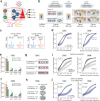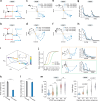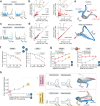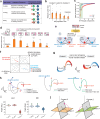Mediodorsal thalamus regulates task uncertainty to enable cognitive flexibility
- PMID: 40097445
- PMCID: PMC11914509
- DOI: 10.1038/s41467-025-58011-1
Mediodorsal thalamus regulates task uncertainty to enable cognitive flexibility
Abstract
The mediodorsal (MD) thalamus is a critical partner for the prefrontal cortex (PFC) in cognitive control. Accumulating evidence has shown that the MD regulates task uncertainty in decision making and enhance cognitive flexibility. However, the computational mechanism of this cognitive process remains unclear. Here we trained biologically-constrained computational models to delineate the mechanistic role of MD in context-dependent decision making. We show that the addition of a feedforward MD structure to the recurrent PFC increases robustness to low cueing signal-to-noise ratio, enhances working memory, and enables rapid context switching. Incorporating genetically identified thalamocortical connectivity and interneuron cell types into the model replicates key neurophysiological findings in task-performing animals. Our model reveals computational mechanisms and geometric interpretations of MD in regulating cue uncertainty and context switching to enable cognitive flexibility. Our model makes experimentally testable predictions linking cognitive deficits with disrupted thalamocortical connectivity, prefrontal excitation-inhibition imbalance and dysfunctional inhibitory cell types.
© 2025. The Author(s).
Conflict of interest statement
Competing interests: The authors declare no competing interests.
Figures









Similar articles
-
Mediodorsal thalamus nucleus-medial prefrontal cortex circuitry regulates cost-benefit decision-making selections.Cereb Cortex. 2024 Dec 3;34(12):bhae476. doi: 10.1093/cercor/bhae476. Cereb Cortex. 2024. PMID: 39668425
-
Peripuberty Is a Sensitive Period for Prefrontal Parvalbumin Interneuron Activity to Impact Adult Cognitive Flexibility.Dev Neurosci. 2025;47(2):127-138. doi: 10.1159/000539584. Epub 2024 Jun 3. Dev Neurosci. 2025. PMID: 38830346 Free PMC article.
-
Differential Roles of Mediodorsal Nucleus of the Thalamus and Prefrontal Cortex in Decision-Making and State Representation in a Cognitive Control Task Measuring Deficits in Schizophrenia.J Neurosci. 2020 Feb 19;40(8):1650-1667. doi: 10.1523/JNEUROSCI.1703-19.2020. Epub 2020 Jan 15. J Neurosci. 2020. PMID: 31941665 Free PMC article.
-
The unique role of the associative thalamus in cognitive processing.Brain Res Bull. 2025 Sep;229:111432. doi: 10.1016/j.brainresbull.2025.111432. Epub 2025 Jun 16. Brain Res Bull. 2025. PMID: 40516661 Review.
-
The Mediodorsal Thalamus: An Essential Partner of the Prefrontal Cortex for Cognition.Biol Psychiatry. 2018 Apr 15;83(8):648-656. doi: 10.1016/j.biopsych.2017.11.008. Epub 2017 Nov 15. Biol Psychiatry. 2018. PMID: 29275841 Free PMC article. Review.
Cited by
-
Developing algorithmic psychiatry via multi-level spanning computational models.Cell Rep Med. 2025 May 20;6(5):102094. doi: 10.1016/j.xcrm.2025.102094. Epub 2025 Apr 28. Cell Rep Med. 2025. PMID: 40300598 Free PMC article. Review.
References
-
- Bach, D. R. & Dolan, R. J. Knowing how much you don’t know: a neural organization of uncertainty estimates. Nat. Rev. Neurosci.13, 572–586 (2012). - PubMed
MeSH terms
Grants and funding
- 132642/U.S. Department of Health & Human Services | NIH | National Institute of Mental Health (NIMH)
- 139352/U.S. Department of Health & Human Services | NIH | National Institute of Mental Health (NIMH)
- 056394/U.S. Department of Health & Human Services | NIH | National Institute on Drug Abuse (NIDA)
- R01 MH118928/MH/NIMH NIH HHS/United States
- P50 MH132642/MH/NIMH NIH HHS/United States
LinkOut - more resources
Full Text Sources
Miscellaneous

